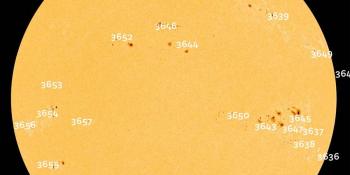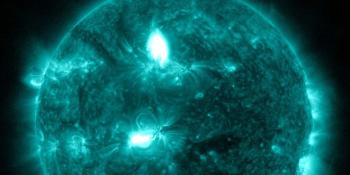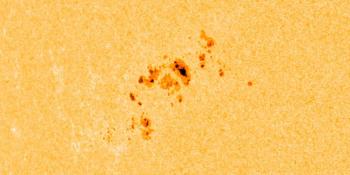Viendo archivo del viernes, 4 octubre 2002
Informe actividad solar
Any mentioned solar flare in this report has a scaling factor applied by the Space Weather Prediction Center (SWPC). Because of the SWPC scaling factor, solar flares are reported as 42% smaller than for the science quality data. The scaling factor has been removed from our archived solar flare data to reflect the true physical units.
Informe de actividad Solar-Geofísica 2002 Oct 04 2200 UTCPreparado por NOAA © SWPC y procesado por SpaceWeatherLive.com
Informe conjunto USAF/NOAA de actividad Solar y Geofísica
SDF Número 277 Publicado el 2200Z a las 04 Oct 2002IA. Análisis de regiones solares activas y de actividad desde 03-2100Z hasta 04-2100Z Solar activity reached high levels. A total of five
M-class flares were observed this period. Region 137 (S19W20) was
the primary source for this activity, producing four M-class flares,
the largest being an M4/1n at 04/0538Z. A delta configuration was
observed to develop in this region late yesterday, and the region
exhibited frequent flare activity since. Region 139 appears to be
growing quickly as it rotates into view. This region produced an
M1/1f flare with associated Type II sweep (357 km/s) at 04/1255Z,
and also produced several moderate C-class flares. A delta
configuration is obvious and white light areal coverage is nearing
500 millionths. New Region 140 (S07E76) was numbered today.
IB. Pronóstico de la actividad solar
Solar activity is expected to be at
moderate to high levels. Complex Regions 137 and 139 will continue
to produce M-class activity, with increasing likelihood for a major
flare from Region 139 as it continues to develop.
IIA. Resumen de la actividad geofísica 03-2100Z a 04-2100Z
The geomagnetic field was at predominantly active to major storm
levels with an isolated severe storm period between 04/00 - 03Z.
Though solar wind speed remains below 450 km/s, the Bz component of
the interplanetary magnetic field was sustained southward for the
entire period, ranging from -2 to -12 nT. The storm was gradually
subsiding by the end of the period.
IIB. Pronóstico de la actividad geofísica
The geomagnetic field is
expected to range from unsettled to minor storm levels with isolated
major storm periods possible. Transient effects from CMEs observed
early on 3 Oct and again on 4 Oct will likely enhance the disturbed
periods on days two and three. A large, recurrent southern coronal
hole will move into geoeffective position late on day three.
III. Probabilidades del evento 05 Oct a 07 Oct
| Clase M | 60% | 60% | 60% |
| Clase X | 10% | 10% | 10% |
| Protón | 05% | 05% | 05% |
| PCAF | green | ||
IV. Penticton 10.7cm flujo
Observado 04 Oct 158 Previsto 05 Oct-07 Oct 160/170/180 Media de 90 Días 04 Oct 179
V. Índices Geomagnéticos A
Observado Afr/Ap 03 Oct 022/033 Estimado Afr/Ap 04 Oct 035/045 Previsto Afr/Ap 05 Oct-07 Oct 018/020-015/020-012/015
VI. Probabilidades de Actividad Geomagnética 05 Oct a 07 Oct
| A. Latitudes Medias | |||
|---|---|---|---|
| Activo | 50% | 50% | 40% |
| Tormenta Menor | 25% | 25% | 20% |
| Tormenta Mayor-Severa | 15% | 15% | 05% |
| B. Latitudes Altas | |||
|---|---|---|---|
| Activo | 50% | 50% | 50% |
| Tormenta Menor | 30% | 30% | 30% |
| Tormenta Mayor-Severa | 20% | 20% | 20% |
< < Ir a la visión general diaria
Últimas noticias
Últimos mensajes del foro
Incoming Active Regions 232Filaments and prominences 56Unproven theories 355AR3654 33Growth of Cycle 25 435
Más temasApoye a SpaceWeatherLive.com!
Mucha gente viene a SpaceWeatherLive para seguir la actividad del Sol o previsión de aurora, pero con esta cantidad de tráfico se incrementan los costos del servidor. ¡Considere hacer una donación si disfruta de SpaceWeatherLive para que podamos mantener el sitio web en línea!

Hechos clima espacial
| Último evento clase X | 2024/03/28 | X1.1 |
| Último evento clase M | 2024/04/30 | M1.6 |
| Últimas tormentas geomagnéticas | 2024/04/26 | Kp5+ (G1) |
| Días sin manchas | |
|---|---|
| Último día sin manchas | 2022/06/08 |
| Promedio de manchas solares mensuales | |
|---|---|
| marzo 2024 | 104.9 -19.8 |
| Last 30 days | 141.7 +36.9 |


